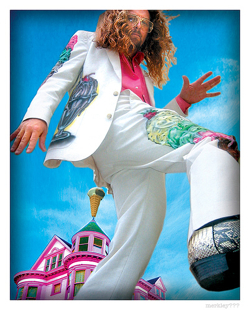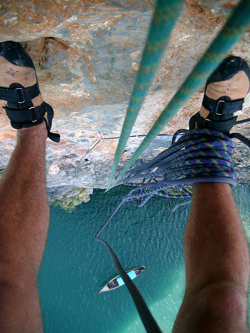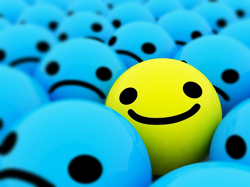Monday, April 5, 2010
Monday, March 29, 2010
ART OF STUDY
Study is hard only when we are not learning in the right way. Use ART OF STUDY for smart and effective study.
Active learning: generate questions, takes notes in your own words, summarise, etc.
Review the materials regularly to remember what you have learnt. For lecture notes, review immediately after the lesson or on the same day to consolidate memory.
Tackle difficult subjects by looking for an easier textbook and do not put them off. You may even have to read a junior college textbook if the problem lies with your foundation.
Organise yourself – Organise your time, study space and the materials you have learnt so that you can study more effectively.
Focus on what you are studying. This requires you to direct your attention and energy to what you are studying. Focusing helps you to absorb the information and aid your memory.
Set goals – Set both your academic and personal goals. During study time, set the goals you want to accomplish for the specific study period.
Teach someone or an imaginary person what you have studied. This helps you to evaluate your understanding of the subject matter and remember better.
Use spaced repetition. Spaced repetition means that the reviews are spread out and that the intervals between each review gets longer and longer. For example, instead of studying Lecture 1 of Chemistry three or four times in one go, spread them out by studying it once on Monday, then again on Tuesday to consolidate the memory, the next review can be a week after that and so on.
Develop a positive attitude toward study by looking for areas where you can inject interest in and seeing it as an important step toward achieving your long-term goal.
You are the one who can make the difference, so understand yourself – your learning style, motivation, goals - and learn to manage your time, feelings, and desires.
Sunday, March 28, 2010
11 traits of highly creative people
Do You Have These 11 Traits of
Highly Creative People?
by Dean Rieck

Would you like to be more creative in your copy and blogging? It’s really not as hard or mysterious as you might think.
One roadblock that prevents many people from boosting their creativity is the notion that creativity is linked to intelligence. Another roadblock is the idea that creative people are born that way.
So if you’re not super smart or born with the creative “gift,” the natural reaction is to shrug your shoulders and give up. That’s probably a bad move.
Research shows that once you get slightly above an average I.Q., intelligence and creativity are not related. So you could be a genius and display little creativity or have fairly average intelligence and wield amazing creative powers.
And to a large degree, creativity is a learned behavior. It’s a matter of how you approach things, how you act or react to new circumstances, your proclivity to look at things in different ways, your willingness to question, experiment, and take chances. In other words, creativity is not “what you are” as much as “what you do.”
Think of creativity as a muscle. The more you use it, the stronger it gets. To increase your creativity, you simply need to “act” like a creative person. Not surprisingly, people recognized as creative tend to share common traits.
Highly creative people:
- Have the COURAGE to try new things and risk failure. Every big breakthrough starts as a harebrained idea. This doesn’t mean you should constantly go off the deep end, just that you should balance your routine portfolio of solutions with an investment in the new and untried. Over time, the risk is usually worth the reward.
- Use INTUITION as well as logic to make decisions and produce ideas. When Matt Drudge designed his Web site, he listened to his gut instead of the Internet gurus. He kept it simple, small, fast, and some would say ugly and primitive. But it works for him, making The Drudge Report one of the most recognizable and popular sites in the world.
- Like to PLAY, since humor and fun are the ultimate creative act. Which is to say you just have to lighten up. We all have goals, and quotas, and deadlines, but it’s not life and death. When you enjoy yourself, your brain relaxes and is able to produce more and better ideas. One of those ideas may be just what you’re looking for.
- Are EXPRESSIVE and willing to share what they feel and think, to be themselves. Blogging is the ideal arena for injecting your personality into your work. People are emotional creatures and respond better to people who appear real, honest, and open. Not only is it more interesting, it can also be more persuasive.
- Can FIND ORDER in confusion and discover hidden meaning in information. Research and critical thinking are key tools for the creative person. Information is to the brain what food is to the stomach. So-called “writer’s block” or creative burnout almost always results from a lack of fresh information and having nothing meaningful to say.
- Are MOTIVATED BY A TASK rather than by external rewards. You must like the challenge of writing, explaining, teaching, andpersuading. Sure, you can make money along the way, but if you’re in it just for the money, you’re not going to be a fountain of new ideas.
- Have a need to FIND SOLUTIONS to challenging problems. Even the most creative writers won’t have a solution for everything. If they claim to, they’ve stopped thinking. Highly creative people are those whose eyes light up at a question they can’t answer. That’s the opportunity to learn something new and produceremarkably creative content.
- Will CHALLENGE ASSUMPTIONS and ask hard questions to discover what is real. Writing, blogging, or business rules aren’t really rules, only rules of thumb. If you want to wield true creative power, you will always take what others advise with a grain of salt. (That includes all of us gurus who love to don our pointy wizard hats and pontificate on the secrets of success.) If you don’t know something from personal knowledge or experience, you don’t know it at all.
- Can MAKE CONNECTIONS between old ideas to produce new insights. Combine the little doodles you make on a white board with online video and you get CommonCraft, a new approach to explaining things to people in a way they can easily understand. Sometimes the best solutions are simply two old ideas jammed together.
- Will PUSH THE ENVELOPE in order to expand the boundaries of what is possible. There was a time when no one thought you could make money on the Internet. Now it’s a huge, multi-national business platform. Instead of dividing the world into the possible and impossible, it’s better to merely divide it into the tried and the untried. What have you not tried yet?
- Are willing to TEST new ideas and compete with others based on results. Isn’t that what they mean by the “market of ideas”? Isn’t that what business competition is about? If you’re afraid of being wrong or losing, your creativity will suffer.
These are certainly uncommon traits for most people. But they’re not difficult. Watch how the creative people you know solve problems and deal with projects. You may choose one particularly creative person you admire and, when faced with a problem, ask yourself, “What would so-and-so do in this situation?”
As you begin to “act” like a creative person, you’ll find yourself actually becoming more and more creative. And likely, more and more successful.
The 6 Characteristics of Highly Creative People
The 6 Characteristics of Highly Creative People
Thomas Moore said, "We are all poets and artists as we live our daily lives, whether or not we recognize our role and whether or not we believe it." Human beings have an innate need to create. Even you! There is a continuum of creativity, ranging from being slightly creative to highly creative. The good news is that you can learn to be more creative by observing creative people and modeling yourself after them. Artists, writers, and creative types seem to have similar characteristics. Some of the personality traits listed below may seem eccentric, odd, even "out there"---but that is where creativity lies--- in the outreaches of our consciousness, in the depths of our souls. If you had the opportunity to speak to Picasso, Walt Disney, or Jane Austen, you would probably find out that they are ordinary people, much like you and I. The difference is that they have allowed more of their soul to come out and play and have freed themselves of convention and restriction. Creativity is essentially the art of discovery and an act of faith. When you create something--- a work of art, book, software program, dance routine, or role for a play, you discover parts of yourself that you never knew existed. Creative people have a strong need to express more of who you really are and often have to fight for that right. The character Isabelle in the movie, Fire and Ice, has a great outlook on what it means to be creative, she says, "To create, sometimes you must rebel."
1. Unconventional
Creative people do not feel the need to conform to society's standards. They often swim against the current and flow with their own way of thinking and living. They have original ideas that literally turn the world upside down and right-side out. Take for example, the 16th century Italian astronomer, Galileo, who proved that the earth revolved around the sun (instead of the other way around), which was revolutionary in his time.
2. Individualistic
Creative people want to find out what the truth is, and they have a strong need to decide for themselves what works and what does not. Often they are ahead of their time, and much of their work is appreciated/acknowledged after they are dead and gone. Many writers are famous for marching to the tune of their own drum, such as Ralph Waldo Emerson, who wrote the book, Self-Reliance, and Robert Frost who penned, "two roads diverged in a wood, and I took the one less-traveled."
3. Inventive
Creative people live in the world of ideas, and don't always have the best interpersonal skills. Because they are so highly intelligent, and live in the realm of possibility, they are constantly coming up with bright ideas. They also take notice of what is missing in the world and/or what could be improved. Take for instance, Thomas Edison, who invented hundreds of things in his time, his most famous invention being the light bulb. He saw that there was darkness and then created light.
4. Driven
Creative people cannot "not do something"—they are almost compulsive until they can bring their internal vision into fruition. They have that "fire in their belly"---a passion to contribute to the beauty and betterment of the world. Because of their high drive, they can produce a lot in a relative short amount of time. Talk about drive---the material girl herself, Madonna, has not let public praise or criticism stop her from being a super star. She is a modern day Diva, multi-talented as a singer, dancer, and actress who has released hundreds of songs, albums, videos, movies, books--- all the while reinventing herself as someone new.
5.Visionary
Creative people have a guiding vision in their head, heart, and soul that they are often called to bring to life. Who else but Michelangelo could look at a large piece of marble and "chip away at everything that wasn't David?" According to him, "I saw an angel in the marble and carved until I set him free." One of his best-known works is the immense ceiling of the Sistine Chapel, which took him three years to complete, where he often had to work upside down for hours at a time. If you ever have seen any of his work, you can easily see that it is a vision to behold.
6. Intuitive
Creative people are very in touch with their inner selves. They pay attention to the signs, synchronicities, symbols around them, and make use of that information in their work. They often act as a channel, where ideas and inspiration come from a higher plane. They allow the work to guide them to where it needs to go. The work clearly originates in their soul, not from their ego. Talk about ideas coming from out of the blue, remember how the scientist, Isaac Newton "discovered" gravity? He was sitting under a tree and an apple fell on his head! Had he not made a connection with his intuitive nature, he would have missed a major theory about the world we live in!
As you read this, do you find yourself relating to some of these traits? If so, it is time to start creating. Getting started can often be the hardest part, because we often limit our creativity by listening too closely to our negative inner voice. But so did all of these examples of creators. Even the famous painter Vincent Van Gogh struggled with that, but he created a remedy for that, he said, "If you hear a voice within you saying, you are not a painter, then by all means, paint, and that voice will be silenced." Robert Henri says, "When the artist is alive in any person, whatever his kind of work may be, he becomes an inventive, searching, daring, self-expressing creature." Once you have created, you now have to put yourself out there for all to see. This is where your faith comes in to support you. Remember that if you are creating from your soul, it will not matter whether other people accept your work or not. You are simply doing what you are called to do as a human being, create.
9 attitudes of highly creative people
9 Attitudes of Highly Creative People
Miscellaneous Blog Tips93 comments
 Yesterday I looked at 5 methods for being creative. Today I’d like to look at some attitudes to build into your approach if you want to be a more creative person:
Yesterday I looked at 5 methods for being creative. Today I’d like to look at some attitudes to build into your approach if you want to be a more creative person:
1. Curiosity
I’ve written previously on the topic of curiositybecause I’m convinced that it is an essential skill to build as a blogger. Learning to ask ‘why’, ‘what if’ and ‘I wonder…’ are great questions to build into your life if you want to be a more creative person.
2. Seeing Problems as Interesting and Acceptable
 One of the problems of the Western mindset is that we often see problems or obstacles in life as unacceptable parts of life. We avoid pain or suppress it when it comes and in doing so don’t often see and feel symptoms that are there to tell us something important. Creative people see problems as a natural and normal part of life – in fact they often have a fascination with problems and are drawn to them.
One of the problems of the Western mindset is that we often see problems or obstacles in life as unacceptable parts of life. We avoid pain or suppress it when it comes and in doing so don’t often see and feel symptoms that are there to tell us something important. Creative people see problems as a natural and normal part of life – in fact they often have a fascination with problems and are drawn to them.
3. Confronting Challenge
Many of the most creative ideas through out history have come from people facing a challenge or crisis and rather than running from it asking ‘how can I overcome this’?
4. Constructive Discontent
Creative people often have an acute awareness of what’s wrong with the world around them – however they are constructive about this awareness and won’t allow themselves to get bogged down in grumbling about it – they take their discontent and let it be a motivation to doing something constructive.
5. Optimism
 Creative people generally have a deeply held belief that most (if not all) problems can be solved. No challenge is too big to be overcome and no problem cannot be solved (this doesn’t mean they’re always happy or never depressed – but they don’t generally get stumped by a challenge).
Creative people generally have a deeply held belief that most (if not all) problems can be solved. No challenge is too big to be overcome and no problem cannot be solved (this doesn’t mean they’re always happy or never depressed – but they don’t generally get stumped by a challenge).
6. Suspending Judgment
The ability to hold off on judging or critiquing an idea is important in the process of creativity. Often great ideas start as crazy ones – if critique is applied too early the idea will be killed and never developed into something useful and useable. (note – this doesn’t mean there is never a time for critique or judgement in the creative process – it’s actually key – but there is a time and place for it).
7. Seeing Hurdles as leading to improvements and solutions
 This relates to some of the above – but by ‘hurdles’ I mean problems and mistakes in the creative process itself. Sometimes it’s on the journey of developing an idea that the real magic happens and it’s often out of the little problems or mistakes that the idea is actually improved.
This relates to some of the above – but by ‘hurdles’ I mean problems and mistakes in the creative process itself. Sometimes it’s on the journey of developing an idea that the real magic happens and it’s often out of the little problems or mistakes that the idea is actually improved.
8. Perseverance
Creative people who actually see their ideas come to fruition have the ability to stick with their ideas and see them through – even when the going gets tough. This is what sets apart the great from the good in this whole sphere. Stick-ability is key.
9. Flexible Imagination
 I love watching a truly creative person at work when they’re ‘on fire’. They have this amazing ability to see a problem or challenge and it’s many potential solutions simultaneously and they have an intuitive knack at being able to bring previously disconnected ideas together in flashes of brilliance that seem so simple – yet which are so impossible to dream up for the average person.
I love watching a truly creative person at work when they’re ‘on fire’. They have this amazing ability to see a problem or challenge and it’s many potential solutions simultaneously and they have an intuitive knack at being able to bring previously disconnected ideas together in flashes of brilliance that seem so simple – yet which are so impossible to dream up for the average person.